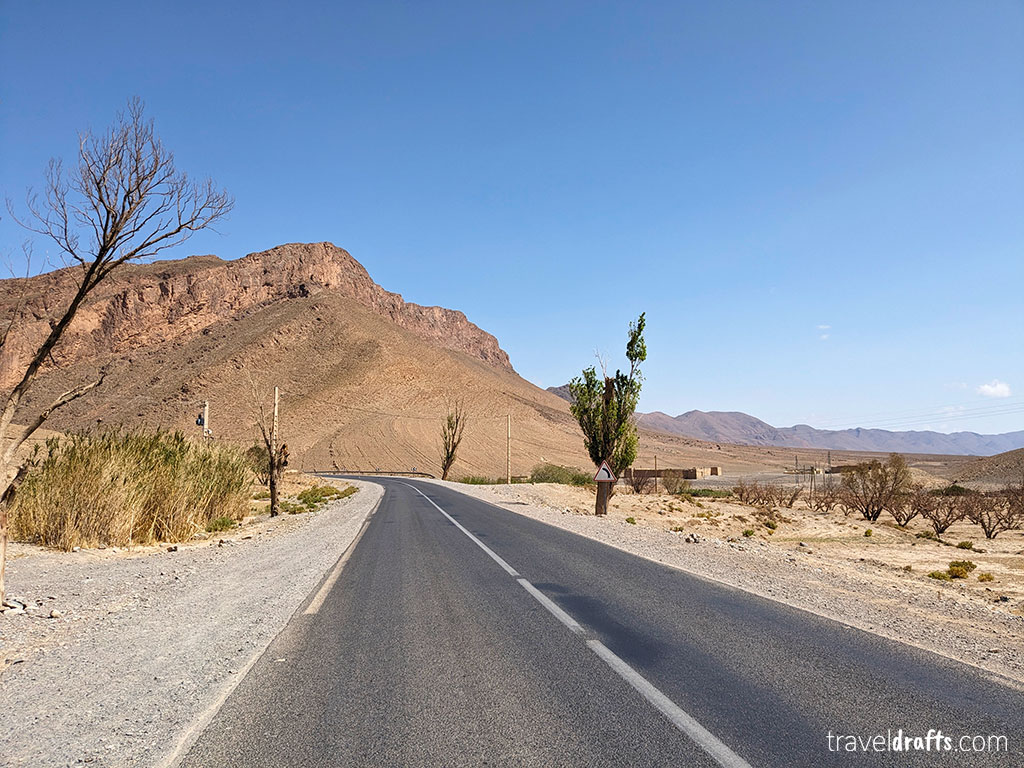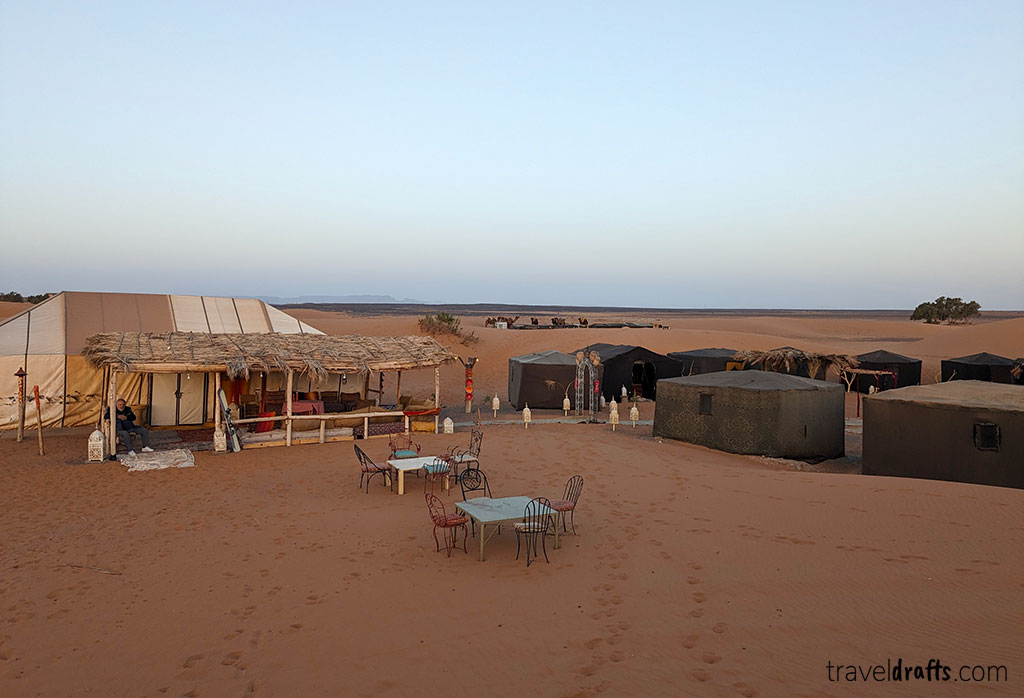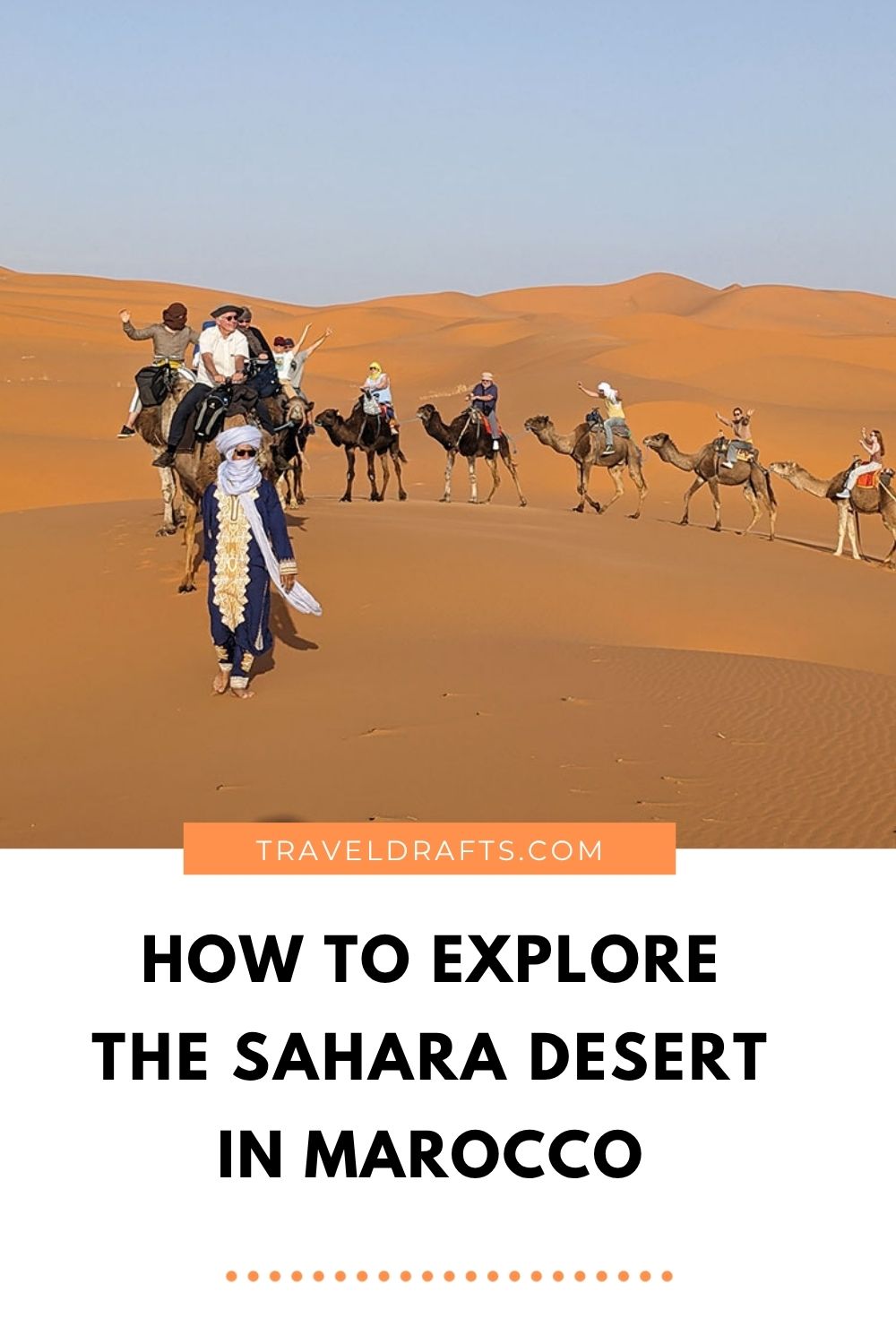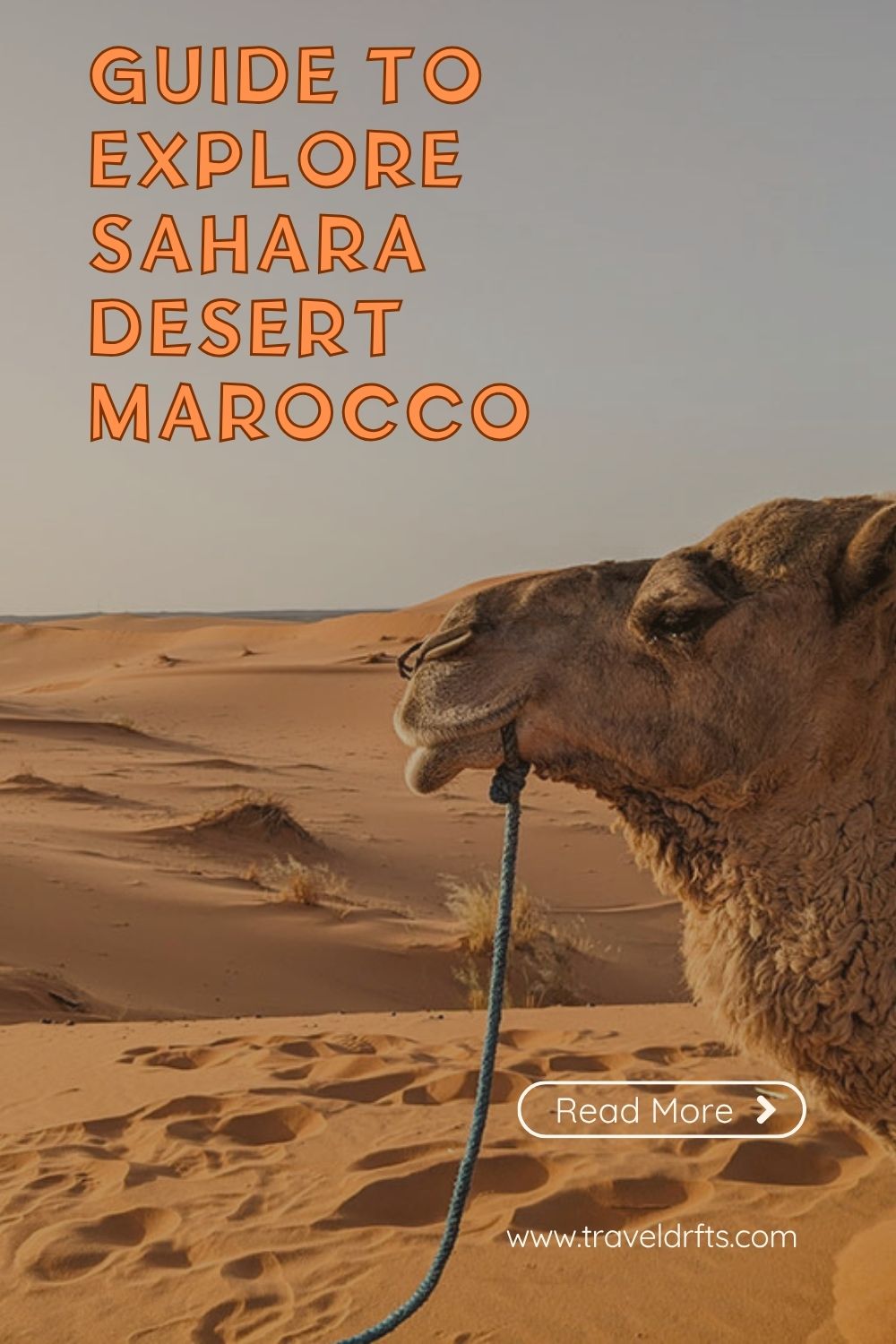Discover how to live an unforgettable adventure in the heart of the Sahara, exploring dunes, camps, and the true essence of the Moroccan desert.
Morocco is a dream destination for many travelers, and one of the main reasons is the Sahara Desert. The endless dunes are stunning and unforgettable. On top of that, you can enjoy several unique activities — spending a night in the desert, riding a camel, quad biking, or exploring by 4×4, among many others.
In this article, we’ll explore the best ways to experience the desert in Morocco — what to expect, who it’s suitable for, the best time to visit, and how much it costs. If you want more Morocco travel tips, check out our article about the 50 things you need to know before visiting Morocco.
We drove to the desert and then joined a one-night tour that included a camel ride and dinner. Based on that experience, we’ll share exactly what to expect from a desert tour.
Page Contents
Merzouga or Zagora?
The first decision you’ll need to make is whether to visit Merzouga or Zagora. If you want to see the sea of dunes, Merzouga is definitely the best option — it’s where you’ll find the Erg Chebbi dunes, the most famous in Morocco.
Zagora also has some dunes, but it’s mostly a rocky desert. Its main advantage is that it’s much closer to Marrakech (and Fez) than Merzouga.
Zagora is about a 6–7-hour drive from Marrakech, while Merzouga takes around 11–12 hours. Don’t underestimate distances in Morocco — long drives are common due to both the distance and the mountain roads.
If your goal is to see the dunes and spend the night in the desert, Merzouga is the clear choice. That’s what we did, and that’s the experience we’ll share.

Can you get there by car?
Yes, it’s absolutely possible to drive to Merzouga — and that’s precisely what we did. Driving lets you stop at points of interest along the way and visit each attraction at your own pace. You can even take a longer route to see other Moroccan cities like Meknes and Fez.
If you can’t or don’t want to drive, there are plenty of tours from Marrakech (or Fez) to Merzouga. Taking an organized tour has the advantage of being completely hassle-free — you relax and enjoy the journey.
Plus, you won’t have to deal with driving, which is a big plus in Morocco, especially in busy cities like Marrakech, where traffic can be chaotic and stressful. Once you’re out on the road, though, driving is calm and straightforward.
In our case, we were on a road trip—we drove from Fez to Merzouga and then to Marrakech. It was a fantastic experience, and if you have the time and don’t mind driving, we highly recommend doing the same.

Which tour should you choose?
For this kind of experience, we almost always book through GetYourGuide, since there are plenty of options and you can read reviews from other travelers, which gives you some assurance of quality.
In our case, we chose this tour from Merzouga, and we absolutely loved it. We highly recommend it! Below, we’ll describe the experience in detail.
If you don’t want to spend the night in the dunes, there’s also the option to take a camel and sandboarding tour only.
What to expect from the Merzouga desert tour
Here’s a breakdown of the exact tour we did and our personal experience. From what we’ve seen and researched, most tours are pretty similar.
The tour starts at Hotel Kasbah Mohayut, a beautiful 4-star hotel with a pool, restaurant, and an excellent breakfast. Despite its great facilities, it’s not expensive — so if you have the time, consider staying an extra night to enjoy other desert activities.
Because of the heat and intense sun, the tour starts at 6 PM in summer and 4 PM during the rest of the year. When you arrive, head to the reception to check in.
Try to arrive a bit early so you can check in calmly. If you need to wait, you’re welcome to use the hotel’s facilities. You can also leave your car in the free, gated parking lot, which is safe and secure. Leave everything you don’t need in the car.
The tour begins with a short 4×4 ride to the spot where the camels are waiting. This drive takes about 5 to 10 minutes along dirt tracks leading to the edge of the dunes, where the camels and guides await.

Camel experience in Morocco
One of our main concerns before booking the tour was how the camels were treated. We didn’t want to support any operation that mistreated animals. We had also read several reviews about tours in Morocco, Egypt, and Jordan, where the camels were dirty or smelled bad.
Because of that, we paid close attention to both the animals and the guides. In our experience, the camels were well cared for throughout this tour. The guides were gentle and affectionate with them — you could tell they genuinely cared, even when no one was watching.
The camels were also clean and well-groomed, with no unpleasant smell. We were pleased about that. If animal welfare concerns you, too, we definitely recommend booking the same tour we did.

The camel ride
The first exciting moment is getting on the camel and feeling it stand up with you on top — it can be a bit intimidating at first, but as long as you hold on tight, it’s totally fine. Mounting the camel takes a bit of agility, but almost anyone can do it.
The ride itself is fun and surprisingly easy — you don’t have to do anything! The camels are well-trained and used to carrying people. They follow each other in a line, led by the guide at the front.
Our first camel ride lasted about an hour and went by quickly. We climbed and descended the dunes, heading deeper into the desert until we reached a tall dune where we stopped to sandboard and watch the sunset.
It was interesting to see how the guides reshaped the steeper parts of the dunes so the camels could climb more easily — and probably to make the ride more comfortable for us too.

Sandboarding and Sunset
Sandboarding is simply sliding down the dunes on a board, like surfing or snowboarding. Of course, it’s not for everyone, and it’s completely optional.
We had already tried sandboarding in Swakopmund, and at the time, we found it a bit dangerous — the dunes there were massive, and you could reach very high speeds. In Merzouga, it was much calmer but still fun. If you enjoy adventure sports and a bit of adrenaline, go for it.
A few minutes later, the sun begins to set, and everyone sits down to watch the sunset over the dunes — one of the most beautiful moments of the tour.
After taking plenty of photos, as soon as the sun goes down, it’s time to get back on the camels for another short ride to the camp. By the time we arrive, it’s almost completely dark, but the camp is lit with torches, creating a very cozy atmosphere.

Dinner and Camp
The camp is well-organized, with private tents for each group or couple, a large dining tent, a bonfire area for the post-dinner party, and bathrooms. It’s basic, but it has everything you need for one night.
Dinner was quite good, with traditional Moroccan dishes like tagine and couscous. They weren’t the best we had on our trip, but they were tasty enough — and eating local dishes in a desert tent is an experience you won’t forget.
After dinner, the guides invite everyone to a small Berber party with music around the fire. There’s singing, drumming (or pretending to), and dancing. It’s not really our thing, but it’s still fun. The party goes on for as long as you want, and when you’re tired, you can simply head back to your tent.
The tents were surprisingly comfortable, with proper beds and bedding — a very welcome touch, especially for anyone who doesn’t enjoy sleeping on the ground.

The Next Morning
In the morning, it’s worth waking up early to catch the sunrise. It’s not as striking as the sunset, but it’s still a beautiful natural sight, with the colors gradually brightening across the desert.
Meanwhile, the camels arrive, and it’s time to pack up for the return trip. Breakfast is included in the tour but is served back at the hotel, not at the camp. So, you’ll hop back on your camel for another 20-minute ride — make the most of it, as it’s your last one.
An interesting note: this final ride is a bit bumpier because part of it is outside the dunes, where there’s no soft sand to cushion the camels’ steps. It’s nothing too uncomfortable, but riding within the dunes is definitely smoother.

Back at the Hotel
When you reach the vans again, it’s time to say goodbye to the camels and head back to the hotel — about a 20-minute drive. Once there, you’re told you can use the hotel facilities freely to freshen up, and breakfast is served in the dining area.
The breakfast room is spacious, and the buffet is excellent and varied, as is typical in Morocco. There’s plenty of fruit, several types of bread, pancakes, honey, butter, jams, and more.
After breakfast, you’re free to relax and enjoy the facilities — the garden and the pool are perfect if the weather is warm. Take a dip, unwind, and soak it all in. That’s exactly what we did before continuing our journey to Marrakech.

Final Notes on Our Sahara Desert Tour in Morocco
One last note about the guides: they were five-star, extremely friendly, and fun. The rest of the hotel staff were also very attentive, which made the entire experience very enjoyable.
Our group was relatively small, between 10 and 15 people, though the camp can accommodate a few more.

How Much Does a Sahara Desert Tour Cost?
This is a relatively affordable experience considering everything it includes. The tour we took cost around 65 euros per person. Check prices here.
Considering it includes three camel rides, sandboarding, sunset in the dunes, dinner, an overnight stay, breakfast, and even the option to shower at the hotel afterward, we think it’s a great deal for an unforgettable experience.
If you want a full tour from Marrakech, prices range between 100 and 120 euros, depending on the agency.
How Many Days Do You Need for the Desert?
If you’re starting from Marrakech, you’ll need three days for either a full organized tour or a self-drive trip. The journey is long, and it’s impossible to fit the camel ride and other activities into a single day.
Usually, tours reach the Dades Gorge on the first day, continue to the desert, and spend the night in the dunes on the second day, then return almost directly to Marrakech after breakfast on the third day.
You can see, for example, this tour, one of the most popular departing from Marrakech.
If you’re driving, we recommend something similar, as there are many points of interest along the route that make it impossible to do the trip in two days. Even without stopping, it’s nearly impossible to reach Merzouga on time for the start of the camel tour from Marrakech.
From Fez, as we did, it’s possible, but you need to wake up very early and can’t really stop along the way.

Destinations Not to Miss Between Marrakech and Merzouga
Since most people travel from Marrakech to Merzouga, it’s essential to make the most of the journey and stop at some attractions along the way. Key stops include:
- High Atlas and Tizi n’Tichka: A spectacular road crossing the High Atlas mountains, reaching 2,260 meters — slightly higher than Mount Pico in the Azores.
- Ait Ben Haddou: A fortified village and UNESCO World Heritage site, featured in films and series like Gladiator and Game of Thrones.
- Ouarzazate: Known as the gateway to the desert, home to Atlas and CLA film studios, and the Kasbah Taourirt fortress.
- Dades Gorge: One of Morocco’s most iconic roads, carved through red and orange cliffs.
- Todra Gorge: An impressive canyon with walls up to 300 meters high.
- Erfoud: A city famous for fossils and marble, a good stop for craft shopping.

Tizi n’Tichka is unavoidable, as it’s on the main road. We recommend prioritizing Ait Ben Haddou (a good overnight stop) and Dades and Todra gorges. Ouarzazate is interesting, but only if you have time. Erfoud is optional for those interested in crafts and fossils.

Best Time to Visit the Sahara Desert
In our opinion, the best times are spring and autumn — late March to early May and October to November.
Avoid the summer due to extreme temperatures. Tours are available in summer, but the experience is much more pleasant in the shoulder seasons and even in winter.
Is It Suitable for Children and Elderly Travelers?
Yes. The tour we did is suitable for children and elderly travelers, as long as they have good balance and some flexibility. We even did it with our parents, and everything went perfectly. Everyone was very attentive.

What to Bring on a Sahara Desert Tour
The desert can be extreme, so preparation is essential. Temperatures vary significantly between day and night, the sun is intense, and sand is everywhere. Here’s what we recommend:
- Clothing and Footwear
- Light, breathable clothing (cotton or linen), especially in summer.
- Jacket or fleece for cooler nights.
- Scarf or shemagh for sun and sand protection.
- Sunglasses with UV protection.
- Hat or cap with a wide brim.
- Comfortable shoes, like sneakers or sandals. Hiking boots aren’t necessary for this tour.
- Sun Protection and Hygiene
- High SPF sunscreen.
- Lip balm to prevent chapped lips.
- Toothbrush and toothpaste, since you’ll spend the night in the desert.
- Essential Gear
- Passport for hotel check-in.
- Small backpack for daily essentials.
- Power bank — no electricity in the desert.
- Reusable water bottle for hydration and to reduce plastic use.
- Useful Extras
- Snacks like energy bars, nuts, or cookies. The provided meals are usually enough.
- A camera for capturing desert landscapes.
- Cash, as ATMs are not always available in the desert.
- Usually Not Needed
- Flashlight — the camp has sufficient lighting, or you can use your phone.
- Sleeping bag — tents are comfortable with proper bedding.

Visiting the Sahara Desert in Morocco is an unforgettable experience, combining dune adventures, camel rides, sandboarding, stunning sunsets, and Moroccan hospitality. With proper planning and preparation, it’s an accessible and safe trip for almost everyone, leaving memories that last a lifetime.
Other articles about Morocco:
Save this list for later reference!

